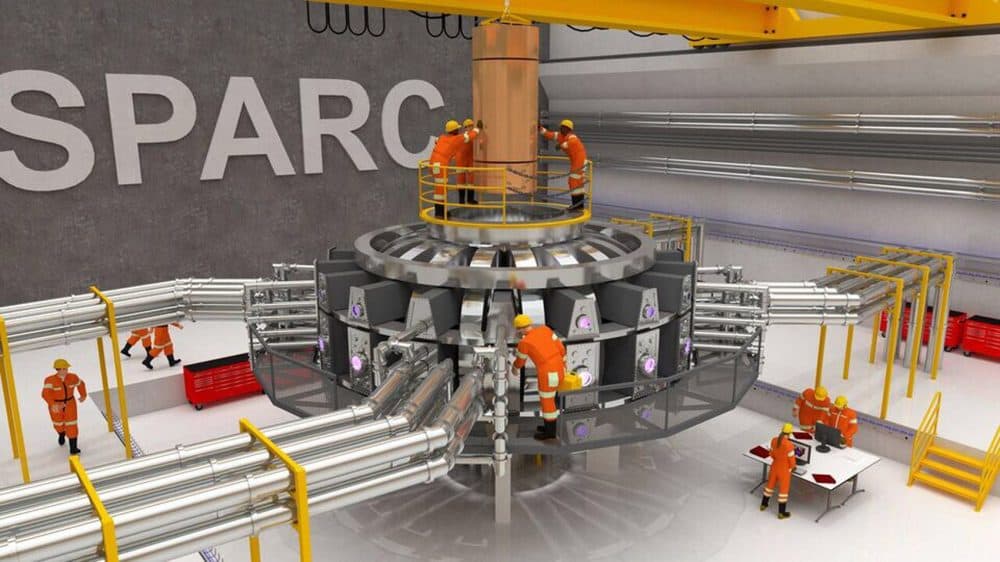Advertisement
MIT Aims To Bring Nuclear Fusion To The Market In 10 Years

MIT fusion physicists have high hopes that technology breakthroughs, along with funding from a private company, will soon bring the power of the sun down to Earth and create a device to safely produce unlimited, non-polluting electricity.
"If we succeed, the world’s energy systems will be transformed,” said Massachusetts Institute of Technology professor Maria Zuber. "An entirely new industry may be seeded potentially with New England as its hub.”
Zuber, the vice president for research at MIT, told reporters by conference call that the university is collaborating with a new Massachusetts-based company to rapidly bring fusion energy to market.
“This commercial investment success will benefit humanity by providing carbon-free power at scale in time to mitigate the deleterious effects of global warming,” Zuber said.
Commonwealth Fusion Systems has donated $30 million to MIT to help fund the effort.
If successful, the science-business partnership could be a breakthrough in a worldwide research effort that has spanned more than half a century.
If you're not familiar with the concept, nuclear fusion is the energy source that powers the sun and stars and gives hydrogen bombs their enormous bang. It's not what's used in nuclear power plants — that's nuclear fission.
But efforts to use nuclear fusion have often petered out, leading to the joke that nuclear fusion is the energy of the future — and always will be.
Unlike fission, which splits atoms to release energy, and produces long-lived and deadly radioactive waste products, fusion requires the nuclei of deuterium (deuteron) and tritium (triton) — forms of hydrogen found in seawater — to fuse.
In the process they release helium and almost unfathomable amounts of energy, without the waste that results from nuclear fission.
Advertisement
Physicists over the years have tried several methods to create fusion in their labs. At the National Ignition Facility in Livermore, California, scientists are using intense lasers to compact tiny pellets of hydrogen. The device is used to model and test the nation’s hydrogen bombs.
However, most experimental fusion devices are based on designs shaped like doughnuts first devised by Soviet scientists in the 1950s, called tokamaks. These use powerful magnets to squeeze deuterium until its nuclei disassociate into sub-atomic particles. This creates temperatures in excess of 100 million degrees, forcing the nuclei to fuse.
On the sun, gravity helps to accomplish this task. In labs, experimentalists have used powerful copper magnets to copy the gravitational effect from the sun. The magnets confine and shape the plasma that results from the fusion.
The MIT researchers now say they plan to use high-temperature superconducting materials to make their magnets. The thin ribbons of superconducting materials are composed of rare earth elements that operate at high temperatures — "high temperatures" being relative. They operate at the freezing point of neon: 40 degrees Kelvin or -388 degrees Fahrenheit. At this temperature electrons flow unimpeded through the ribbons, creating magnetic fields greater than the sun.
Professor Zachary Haftwig, with MIT’s Plasma Science and Fusion Center, says creating these kinds of magnets will reduce the size of the fusion reactor MIT hopes to build, resulting in tremendous efficiencies.
“It turns out increasing the magnetic field results in much higher performance fusion but at drastically smaller scale," he said.
The smaller reactors will be less complex, easier to build and maintain and, they hope, less costly to build.
MIT scientists credit the U.S. Department of Energy for funding fusion research for decades, but under the Trump administration funding has been cut back. An international effort by 35 nations has been building a giant fusion test reactor in the south of France. Called the International Thermonuclear Experimental Reactor (ITER), construction costs have soared to $20 billion and could double by 2035 when the test reactor is finally able to produce more energy than it consumes.
MIT scientists believe their device, dubbed SPARC, will generate ten times more energy within a decade.
They hope the private funding from Commonwealth Fusion Systems will help them reach that goal.
CFS is headed by MIT fusion physicist postdoc Bob Mumgaard. The company has attracted investors, including Italian energy company ENI, to underwrite the SPARC experimental fusion reactor.
There are a few other competing, privately-funded fusion projects in North America, including General Fusion of British Columbia, which hopes to have a prototype built in three to five years, and TAE Technologies of California, with $500 million in funding, backing 20 years of research.
The energy source of the future is still elusive, but scientists are closing in.
Correction: A previous version of this story incorrectly stated the temperature where neon freezes in Fahrenheit. We regret the error.
This article was originally published on March 09, 2018.
This segment aired on March 9, 2018.
